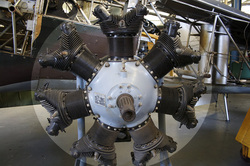WARNER SCARAB ENGINE
 Click on image for larger version
Click on image for larger version
Between 1928 and the early 1940s the Warner Aircraft Corporation of Detroit Michigan USA designed and produced the Scarab series of of seven cylinder air cooled radial aircraft piston engines.
The first was the 110hp Scarab designated S-50 built for the 1928 National Air Races and the aircraft using it dominated their class. Power output was increased to 125hp in 1929 following crankshaft modifications. The 145hp Super Scarab designated SS-50 was introduced in 1933 initially, with the power output being increased to 165hp following modifications and was designated SS165 and certificated in 1939.
The Super Scarab 185 designated SS-50A was a further development produced in 1938 and used in helicopter applications as well as fixed wing aircraft, and a 90hp Scarab Junior five cylinder radial engine was produced in 1930.
Many light aircraft of the time were powered by Scarab engines including the Australian CA-6 Wackett Trainer and the Americans, Fairchild F-24, GeeBee Sportster Model E, and Ryan, Stinson and Waco products.
The Super Scarab 165 was the last engine produced by the Warner company as it was taken over by Clinton Machine Company in 1950.
|
TECHNICAL DATA - S-50
Type Length Diameter Height Bore and Stroke Displacement Dry weight Valve system Fuel system Oil system Power output Compression ratio Power to weight ratio |
Seven cylinder air cooled radial piston engine 29in (740mm) 36.6in (930mm) 36.5in (929mm) Bore 4.25in (108mm) and Stroke (108mm) 422 cu in (6.92L) 292 lbs (132kg) 1 inlet and 1 exhaust valve per cylinder Stromberg NA-55A carburettor Dry sump 125hp @ 2,050 rpm @ sea level 5.15/1 0.43hp/lb |
